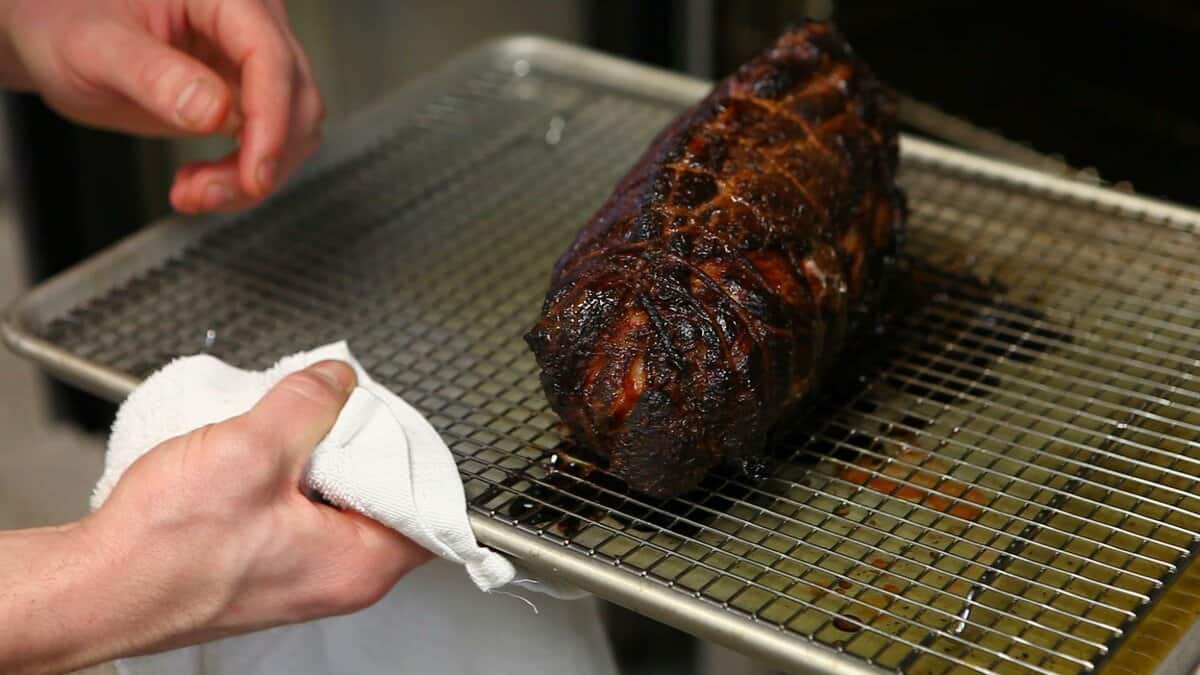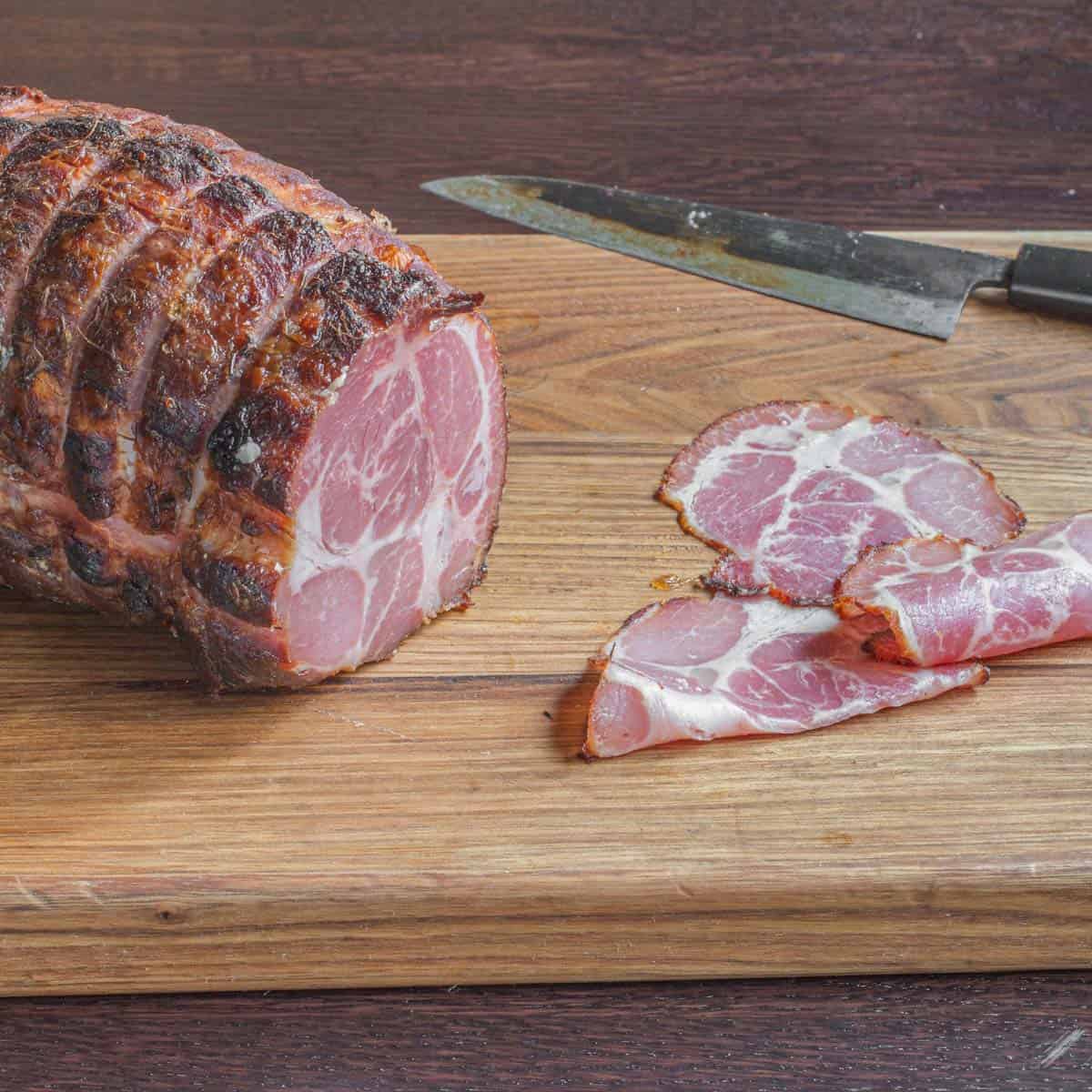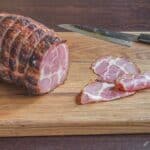A cured, smoked ham infused with the flavor of mature spruce needles picked in the winter is one of the more creative spruce recipes I've made.

Spruce and pine needles have a great aroma but you need some tools, specifically a high speed blender that can break them up and release their aroma. It also takes time for the flavor to penetrate meat, and since a ham has to stay in brine for a while it's a great candidate.
Chris Bohnhoff and I shot a little tutorial of this too, which turned out really great.
The Flavor
The flavor of the ham is delicate, it's not really meant to be drowned with cheese and mayonnaise on a sandwich or something like that, it's better by itself, maybe with a little toast, butter and some mustard or pickles.
Now most people aren't going to cure a whole ham at home when they're readily available at other places, so this recipe is more feasible at home since it's made from a muscle cut out of a pork shoulder called the coppa eye.
It should go without saying that you don't have to actually flavor this with spruce, it's just an idea. Wild juniper and cedar berries made a great version of this too. An herby ham would be great as well, if you don't feel like picking anything-substituting rosemary for the spruce needles would yield a ham with a much stronger flavor.
Spruce / Pine Ham
Equipment
- Large plastic container for curing
- Smoker
Ingredients
- 1 one coppa eye taken from a pork shoulder
- For the brine
- 1 gallon water
- 3 ounces pink curing salt sodium nitrite
- 1 bulb garlic halved
- 1.5 cups salt
- 3 cups light brown sugar
- 1 qt spruce needles from a non bitter species picked from the branches
- 2 tablespoons black peppercorns toasted
Instructions
- Rinse the spruce needles in cold water to remove any debris. Bring the water, salt, sugar, pink salt, garlic, and peppercorns to a boil, then chill.
- Remove 1 qt of the water and puree with the spruce needles in a highspeed blender until very fine, then recombine with the remaining brine. Truss the ham with butcher's twine, then in a 5 gallon cambro and cover with the brine. Wight down the ham with plates to ensure even infusion of the aromatics. Label and date the container. Rotate the ham in the brine every other day for 2 weeks. At the end of 1 week, remove the ham from the brine.
- Place the ham on a cookie sheet with a baking rack to ensure even caramelization, and cook until the internal temperature reaches 145 degrees, then put it in a hotel pan, weighted down with another hotel pan on top with vinegar bottles or another weight to hold it down. The next day, remove the ham from the pan, reserve the aspic for another purpose. Wrap the ham very tightly in plastic wrap and refrigerate or freeze until needed.



Thomas Knoll
I've cured ham from boneless pork butt before. Since getting the eye it self would be rather expensive would you say you could have a good result using a boneless butt for this? I am quite curious to try it... I have some wood chips I'd smoke it with that were soaked in a locally made mead even here in Wisconsin. .
Also before I do and break off pine needles in my backyard; any thing specific varieties you know that would be quite dangerous in the pine family?
Alternatively; would you say a pork loin would work? My concern being the low fat to meat ratio. I buy centercut loin, so there is almost no fat..
I just found your site and it has me wanting to go exploring my area here in WI for edibles in the woods already and has me planning a trip to Northern WI for Fiddleheads in the season!
Alan Bergo
Hi Thomas.
You can absolutely use a boneless butt for this. The eye is the choicest part, but you could roll up another section of the shoulder, it just won't be as pretty. I'd use shoulder for this first, before a loin, but you could do both--just don't over cook the loin, bring it to 145F as opposed to 150F for the straight ham.
Gordon Hester
If I’m correct in thinking that the “pink salt” in your recipe is the curing salt also known as Prague Powder #1, then 3 ounces of it really seems like a lot! When I make cured meats I typically use only 2 or 3 tablespoons in 4 or 5 gallons of water. Am I missing something here?
Alan Bergo
You’re right, and I should clarify the difference in salts here, so thanks for the reminder. As for the proportions, they are taken directly from the book “charcuterie” by Michael Ruhlman and Bryan Polcyn, which is a tried and true industry standard. If you prefer using less sodium nitrite in your brine, and dry cures, you can sure get away with a little less, and I have occasionally, especially if I’m scaling very large batches, or if I’m trying to stretch product. Get too skimpy
And your ham will taste weak though, by the same token, too much pink salt is gross, and makes meat look neon pink.
Rebecca Bryant
Are you leaving the ham on the counter overnight when weighted? Or refrigerated while weighted?
Alan Bergo
Refrigerated.
Rebecca Bryant
Thank you. 🙂
Liz Terrance
That looks phenomenal!